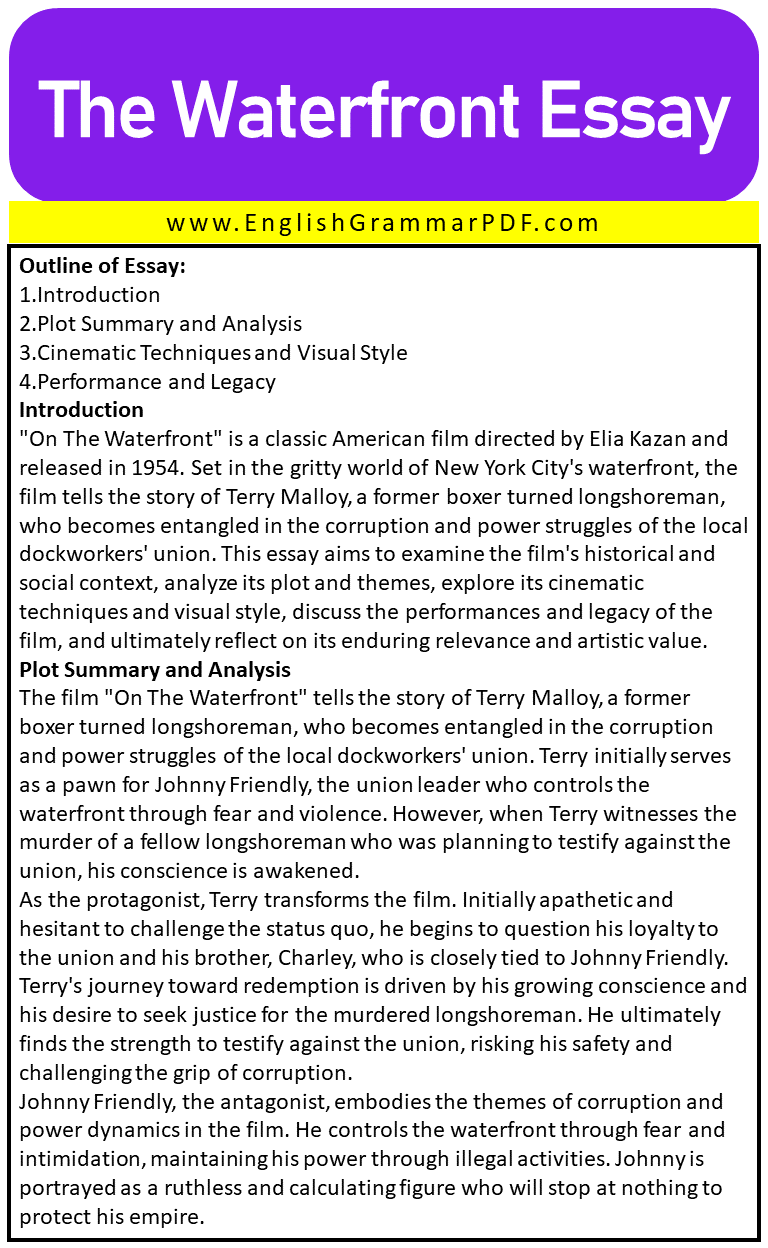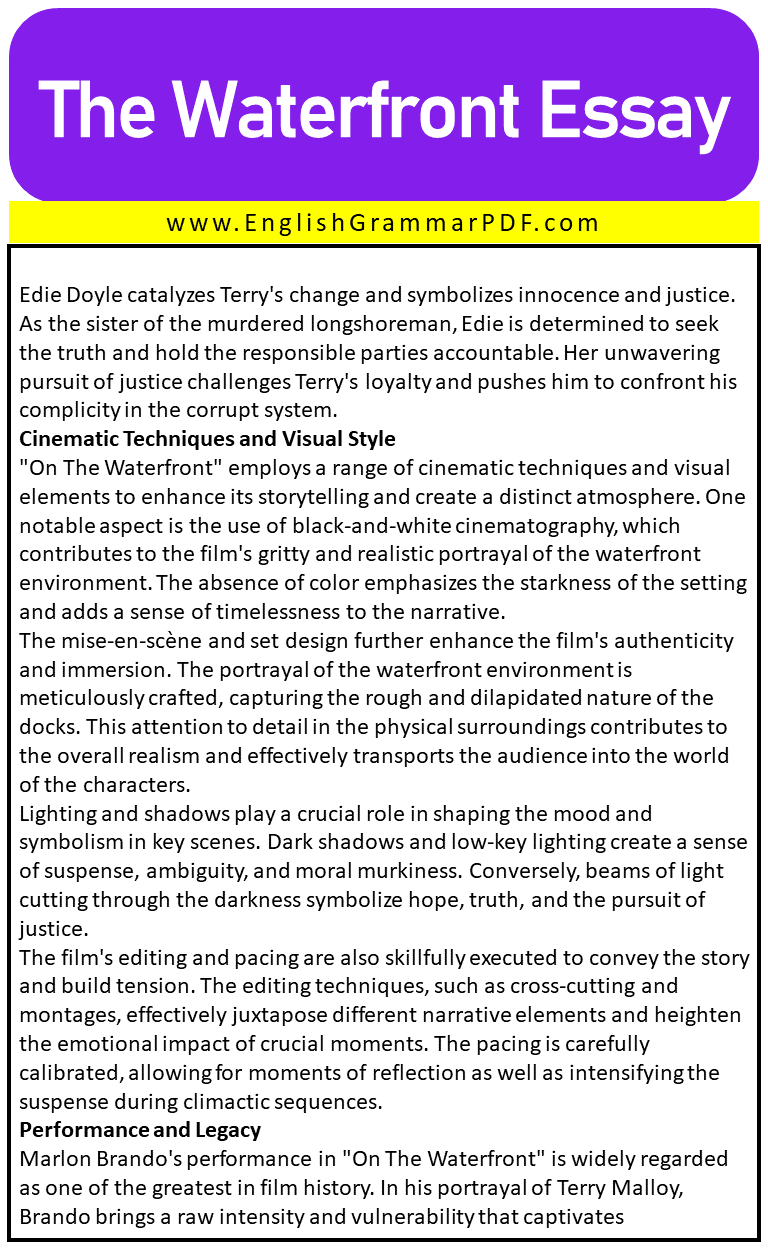The Waterfront Essay
Outline of Essay:
- Introduction
- Plot Summary and Analysis
- Cinematic Techniques and Visual Style
- Performance and Legacy
Introduction
“On The Waterfront” is a classic American film directed by Elia Kazan and released in 1954. Set in the gritty world of New York City’s waterfront, the film tells the story of Terry Malloy, a former boxer turned longshoreman, who becomes entangled in the corruption and power struggles of the local dockworkers’ union. This essay aims to examine the film’s historical and social context, analyze its plot and themes, explore its cinematic techniques and visual style, discuss the performances and legacy of the film, and ultimately reflect on its enduring relevance and artistic value.
Plot Summary and Analysis
The film “On The Waterfront” tells the story of Terry Malloy, a former boxer turned longshoreman, who becomes entangled in the corruption and power struggles of the local dockworkers’ union. Terry initially serves as a pawn for Johnny Friendly, the union leader who controls the waterfront through fear and violence. However, when Terry witnesses the murder of a fellow longshoreman who was planning to testify against the union, his conscience is awakened.
As the protagonist, Terry transforms the film. Initially apathetic and hesitant to challenge the status quo, he begins to question his loyalty to the union and his brother, Charley, who is closely tied to Johnny Friendly. Terry’s journey toward redemption is driven by his growing conscience and his desire to seek justice for the murdered longshoreman. He ultimately finds the strength to testify against the union, risking his safety and challenging the grip of corruption.
Johnny Friendly, the antagonist, embodies the themes of corruption and power dynamics in the film. He controls the waterfront through fear and intimidation, maintaining his power through illegal activities. Johnny is portrayed as a ruthless and calculating figure who will stop at nothing to protect his empire.
Edie Doyle catalyzes Terry’s change and symbolizes innocence and justice. As the sister of the murdered longshoreman, Edie is determined to seek the truth and hold the responsible parties accountable. Her unwavering pursuit of justice challenges Terry’s loyalty and pushes him to confront his complicity in the corrupt system.
Cinematic Techniques and Visual Style
“On The Waterfront” employs a range of cinematic techniques and visual elements to enhance its storytelling and create a distinct atmosphere. One notable aspect is the use of black-and-white cinematography, which contributes to the film’s gritty and realistic portrayal of the waterfront environment. The absence of color emphasizes the starkness of the setting and adds a sense of timelessness to the narrative.
The mise-en-scène and set design further enhance the film’s authenticity and immersion. The portrayal of the waterfront environment is meticulously crafted, capturing the rough and dilapidated nature of the docks. This attention to detail in the physical surroundings contributes to the overall realism and effectively transports the audience into the world of the characters.
Lighting and shadows play a crucial role in shaping the mood and symbolism in key scenes. Dark shadows and low-key lighting create a sense of suspense, ambiguity, and moral murkiness. Conversely, beams of light cutting through the darkness symbolize hope, truth, and the pursuit of justice.
The film’s editing and pacing are also skillfully executed to convey the story and build tension. The editing techniques, such as cross-cutting and montages, effectively juxtapose different narrative elements and heighten the emotional impact of crucial moments. The pacing is carefully calibrated, allowing for moments of reflection as well as intensifying the suspense during climactic sequences.
Performance and Legacy
Marlon Brando’s performance in “On The Waterfront” is widely regarded as one of the greatest in film history. In his portrayal of Terry Malloy, Brando brings a raw intensity and vulnerability that captivates the audience. He seamlessly transitions between toughness and emotional depth, displaying a range of conflicting emotions and internal struggles. Brando’s iconic “I coulda have been a contender” monologue has become legendary, showcasing his ability to convey anguish, regret, and a profound sense of missed opportunities.
The supporting cast also delivers outstanding performances. Eva Marie Saint shines as Edie Doyle, bringing a delicate strength to her character and providing a moral compass for Terry’s transformation. Lee J. Cobb gives a chilling portrayal of Johnny Friendly, infusing the character with menace and power. The performances collectively elevate the film and contribute to its lasting impact.
“On The Waterfront” received critical acclaim upon its release, earning twelve Academy Award nominations and winning eight, including Best Picture, Best Director for Elia Kazan, and Best Actor for Brando. The film’s success at the box office and its critical reception solidified its place in cinematic history.
The film’s legacy extends beyond awards and accolades. “On The Waterfront” continues to be celebrated for its powerful storytelling, social commentary, and timeless exploration of moral dilemmas. Its influence can be seen in subsequent films that tackle similar themes and in the careers of actors and directors who were inspired by its performances and artistic achievements. The film’s impact on the cinematic landscape is undeniable, making it a significant contribution to the medium and a testament to the enduring power of great performances.
FAQ’s
What is the main message of “On The Waterfront”?
The main message of “On The Waterfront” is the importance of individual conscience and moral responsibility in the face of corruption and oppression.
How is power shown in “On The Waterfront”?
Power is depicted in “On The Waterfront” through the control exerted by Johnny Friendly and the corrupt union over the dockworkers, using fear, violence, and manipulation to maintain their dominance.
Explore More Essays:
Download the PDF of the Essay:






